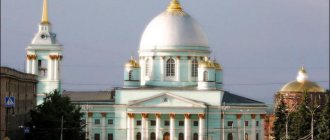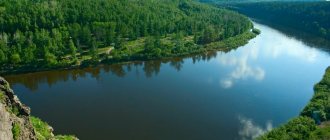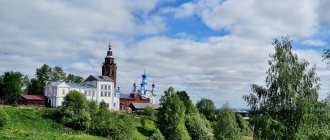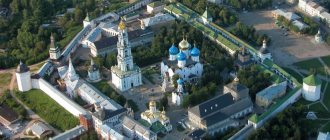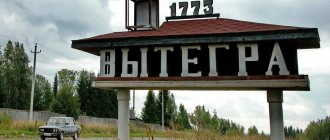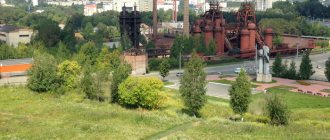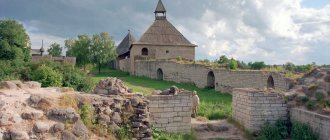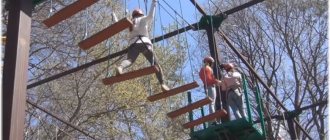Pavlovsky Posad is a cozy old provincial town in the Moscow region. The sights of Pavlovsky Posad are represented by ancient architectural monuments, wooden buildings, natural objects and, of course, painted scarves that warm you up in any cold weather, for which a special museum has been created to display.
In the XIV century. The outskirts of the city were called Vokhonsky volost. Its center was considered the village of Vokhna, which also had the second name Pavlovo. In those days, all this was the property of Prince Dmitry Donskoy.
During the period of hostilities in 1812, a partisan movement developed in these places. This event is immortalized in a monument to its leader, peasant Gerasim Kurin.
A few facts about Pavlovsky Posad
- Mentioned for the first time in 1339 in the spiritual letter of I. Kalita as Pavlovo (Vohna)
- Received the status of a city called Pavlovsky Posad with several villages included in its composition in 1844 by decree of Tsar Nicholas I.
- Actor Vyacheslav Tikhonov and cosmonaut Valery Bykovsky were born in Pavlovsky Posad.
- The population of the city is about 65 thousand people
- Distance from Moscow by highway – 76 km
- The railway station of the same name is located just over 67 km from the Kursky station.
In this area, work is underway to create an open-air museum, which the city should become. So the sights of Pavlovsky Posad are worth seeing.
The main attractions of Noginsk.
How we got to Pavlovsky Posad. By mistake
Recently, my friend and I came up with the idea to go to the Moscow region and capture the Golden Autumn. The choice fell on the Dubrovitsy estate, which is located near Podolsk. Our journey began from the Kursk station. Having successfully purchased tickets at the self-service terminal, we took the train to the Podolsk station and a little over an hour later we arrived in... Pavlovsky Posad. Later it turned out that the schedules of some trains in the Gorkovsky and Kursk directions we needed coincided. Focusing on the train board, we did not notice that we had entered the platform of the Gorky direction. Having already been on the road for about 50-55 minutes, it turned out that we were going in the wrong direction. It should be noted that on the way, inspectors entered the train and did not have any questions about our tickets. But they not only indicated the final destination of the trip, but also the cost: a ticket to Podolsk costs 102 rubles, and to Pavlovsky Posad - 164. Having quickly opened the maps in our smartphones, thanks to the GPS and GLONASS functions, we found out that the nearest large populated areas The point is Pavlovsky Posad. Since neither my companion nor I had visited this city before, and there were no other options, it was decided to get off in this city.
At the exit from the station we had some difficulties, because our tickets were “wrong”. I had to turn to the station staff for help, amusing them with my adventures. As a result, the cheapest tickets were purchased, in which the final destination was Pavlovsky Posad. It cost us about 20 rubles each. You could say we saved money on the road. Leaving the station, we found ourselves on Privokzalnaya Street. My friend wanted to buy a card so as not to waste her smartphone’s battery power. Looking at the city plan, I suggested going to the bank of the Klyazma River, which seemed very close. I expected a beautiful view, but I was disappointed. Turning from Privokzalnaya Street into Kalyaeva Lane, we discovered that it was a dead end. Next began the territory of private houses and something like a forest belt. True, the bell tower of the monastery could be seen through the trees, but there was no path, and I didn’t want to go into the mud, not knowing where. I had to turn around.
Intercession-Vasilievsky Monastery
The sights of Pavlovsky Posad and memorable places of the city open up to tourists literally immediately upon arrival. This list begins with the Pokrovo-Vasilievsky Monastery, founded by local manufacturer Yakov Labzin, who at one time produced scarves.
It was he who built the first two-story church over the graves of his wife Akilina Ivanovna and companion Vasily Gryaznov, which was the beginning of the organization of the monastery. Subsequently, an almshouse was opened at the temple, which was later transformed into a convent.
Unfortunately, during the Soviet period, when there was an active struggle against the church, the monastery was closed, and it was decided to use its buildings as garages and warehouses.
This situation changed only in 1989. Then they began to restore the monastery, recreating a monastery on the basis of the old buildings. Now it contains particles of the relics of saints, as well as ancient icons.
What to see in Pavlovsky Posad
Assuming that it was easiest to ask local residents about attractions, we turned to passers-by. But people were not eager to advertise their city. On the contrary, they seemed surprised that people were coming to them from Moscow to see something. Locals suggested that we visit the Pavlovsky Posad Historical and Art Museum (Pavlovsky Posad, Pokrovskaya Bol St., 38), saying that we wouldn’t like it there. We did not go to the museum, since it is located in the part of the city that is located on the other side of the station. There were fears that while we were spinning around the station, we would lose time and would not see either the monastery, the museum, or the city. I had to ask a specific question: how to get to the Intercession-Vasilievsky Monastery. Having received clear instructions, we returned to the railway station, since there is a bus station nearby. We needed bus 27. This is an intercity route that connects Pavlovsky Posad with Noginsk. According to the schedule, he goes quite often. The fare depends on the distance traveled; travel to the monastery cost 50 rubles. Once on the bus, we finally decided on a plan of action. It was decided to get to the monastery, and from there, on foot, we would return to the station. By the way, the purchased city map was no longer useful. Having disembarked at the fifth stop at the intersection of Mira Street and Mira Lane, we found ourselves on the territory of the Pokrovsko-Vasilievsky Monastery.
On your own in Pavlovsky Posad: scarves and cats photo 2
The territory is very well-groomed, beautiful, but mostly closed to tourists. We were not able to see the Intercession Cathedral located here. We came in during cleaning and moving around the temple was not exactly prohibited, but it was inconvenient. In summer it should be much better here: you can sit on benches, enjoy the warmth and the view of flowering plants.
On your own in Pavlovsky Posad: scarves and cats photo 3
Having left the monastery, we went, as planned, in the opposite direction, to the station. We walked along bus route 27. On the way we examined the Church of the Resurrection of the Word.
On your own in Pavlovsky Posad: scarves and cats photo 4
Strictly speaking, this is not a temple, but a bell tower of a Cathedral destroyed in the mid-20th century. The bell tower was not demolished, but given to the local history museum. At the very end of the last century, the building was returned to the Russian Orthodox Church and now services are held here.
They say that the clock-chimes installed on the bell tower at the end of the 19th century were in no way inferior to those in Moscow and played the anthem “God Save the Tsar.”
On your own in Pavlovsky Posad: scarves and cats photo 5
On your own in Pavlovsky Posad: scarves and cats photo 6
Then, having crossed the pedestrian bridge over the Vokhonka River, we went to the Temple of the Kazan Icon of the Mother of God and went out to Revolution Square.
On your own in Pavlovsky Posad: scarves and cats photo 7
Temple of the Kazan Icon of the Mother of God.
On your own in Pavlovsky Posad: scarves and cats photo 8
Revolution square. Sculptural composition dedicated to the founding of the city.
On your own in Pavlovsky Posad: scarves and cats photo 9
Revolution square. Lenin monument.
On your own in Pavlovsky Posad: scarves and cats photo 10
Being hungry and not wanting to experiment with local catering, we opted for McDonald's. I must say that fast food, which always comes to the rescue, this time disappointed. The room is small, there are a lot of people (it was difficult to find a free table), the self-service terminals are different from those available in Moscow, and most importantly, the menu is somehow “cut down”; there were not even half of the usual sandwiches. As a result, I paid 400 rubles for lunch at a regular McDonald's, which I didn't expect at all. We really regretted that we didn’t go to some local cafe. Well, for example, with such a funny name - “Fed Raccoon”.
On your own in Pavlovsky Posad: scarves and cats photo 11
History says that Pavlovsky Posad was formed in the 19th century by uniting five villages and several hamlets. And you can feel it. In my opinion, this city was never able to become a “city”, a single monolithic organism. Rather, it can be called an urban village. There are a lot of one- or two-story, out-of-date houses here, among which are literally “stuck” high-rise buildings of the 20th and 21st centuries, here not all the streets are covered with asphalt, and there are also cats walking around the city quite calmly, who are not at all afraid of people.
On your own in Pavlovsky Posad: scarves and cats photo 12
Streets of Pavlovsky Posad.
On your own in Pavlovsky Posad: scarves and cats photo 13
A barrack adjacent to a modern high-rise building.
On your own in Pavlovsky Posad: scarves and cats photo 14
Cat basking in the sun.
On your own in Pavlovsky Posad: scarves and cats photo 15
These are the thoughts I left McDonald's with. However, it should be noted that we did not see the entire city. Its territory is quite large and we did not reach the part that is located on the other side of the station. However, the impression has already been formed. There was nothing that surprised me in this city. By this moment we were already ready to return to Moscow. But since I had already called home to share a funny story about how we were traveling to Podolsk, but arrived in Pavlovsky Posad, and immediately received an order for a Pavlovsky Posad scarf, I had to go not to the station, but to look for a store.
Resurrection Cathedral
This religious building is one of the oldest buildings in Pavlovsky Posad. The time of its construction dates back to the beginning of the 18th century, when a stone structure was erected on the site of the Church of St. George the Victorious that stood here.
At first it was just a 5-domed church with a refectory, but in the 19th century. it was completely reconstructed, first erecting a new refectory, and then adding two chapels to it: Dmitrievsky and Sergievsky and a high bell tower.
The reconstruction of the temple lasted for almost 4 decades, and ended only in 1875, when a dome was installed over the refectory.
Unfortunately, the building of the Resurrection Cathedral could not survive the difficult times of the anti-church struggle of the Soviet rulers. It was first closed in 1936, and in the early 1950s it was completely demolished. Of the entire cult complex, only the bell tower has survived to this day, rising on a hill and serving as a real decoration of Pavlovsky Posad.
Museums of Pavlovsky Posad
- Museum of the History of Russian Shawls . This place is especially loved by women, because on 200 square meters there is a unique exhibition - more than four hundred scarves and shawls from various Russian manufactories. The basis of the exhibition was the collection of city resident Vladimir Shishenin, who was the initiator of the creation of the museum.
- Museum of Local Lore . Many are sure that similar museums in provincial towns are very similar to each other, and to some extent this is true. But not in Pavlovsky Posad, where not only exhibits highlighting the history of this city are presented, but also wooden figurines of local craftsmen, painted scarves, miniature copies of Pavlovsky Posad churches and houses. There is also an exhibition dedicated to actor Vyacheslav Tikhonov, a native of the town.
Museum of the History of Russian Shawls
Monuments of Pavlovsky Posad
- Monument to the founding of the town . This is an original sculptural composition depicting five people in ancient costumes: three women and two men. Each figure symbolizes one of the villages that were part of Pavlovsky Posad, as well as folk crafts: women are holding fabric with patterns and scarves (textile production), kanitel (architecture and construction). But men represent farmers and fishermen.
- Monument dedicated to the defenders of the Fatherland . A laconic, but at the same time original monument, installed in 2004. It looks like a pedestal on which the T-64 tank is mounted.
Monument to the founding of the town
Religious buildings - what to see in Pavlovsky Posad
- Naturally, first of all, it is worth mentioning the Pokrovsko-Vasilevsky Monastery , which was founded in the city of Pavlovsky Posad by Yakov Labzin, a local factory owner who opened a factory here for the production of scarves. His companion, Vasily Gryaznov, was a very pious man and petitioned the Moscow Metropolitan to establish a monastery in the city. After the death of Vasily Gryaznov, as well as Labzin’s wife Akilina Ivanovna, the widower built a two-story temple over their graves. There was also an almshouse attached to the temple, which later turned into a convent. During Soviet times, the monastery was closed, and the buildings were used as warehouses and garages. They began to restore the monastery only in 1989 , when the first church was opened here. Today the monastery is for men. Particles of the relics of saints, icons and frescoes were transferred here. Separately, it is worth mentioning the architecture of the monastery, which is considered one of the most “perfect”. The bell tower of the monastery is visible from many streets of the town.
- The Resurrection Cathedral is one of the oldest buildings in Pavlovsky Posad, built at the beginning of the 18th century. Previously, there was a temple in honor of St. George the Victorious, but later a stone structure was erected in its place. Today, all that remains of the cathedral is the bell tower, whose height is 58 meters. It rises on a hill and serves as a real decoration of the city.
- The Church of the Nativity of the Virgin Mary is another ancient building that was previously a cemetery church. In the northern and southern aisles of the temple, iconostases created by masters at the end of the century before last have been preserved.
Pokrovsko-Vasilievsky Monastery
Remarkable places of Pavlovsky Posad
- The fire station building with a tower was built in the second half of the 19th century. The building itself has an original octagonal shape and has an observation deck. A fire museum was organized here, but it was later closed and the exhibits were transferred to the local history museum.
- Shirokov's house is an original architectural monument. It was built by Davyd Shirokov, a local manufacturer, who bequeathed the building to the city. The building itself surprises with its richly decorated facade and luxurious interior decoration. It now houses a local showroom.
- The Labzin estate is an original house that was built in the second half of the 19th century and belonged to the factory owner Yakov Labzin. Today the MPTP of municipal services is located here.
- The house of Vyacheslav Tikhonov is where the main Stirlitz of Soviet cinema spent his childhood and youth. Today, the 1908 building is in poor condition. After the actor’s death, fans hoped that a museum would be opened here, but so far this issue has not been resolved. Natural attractions of Pavlovsky Posad
- The lake is of glacial origin - located near the city, at a distance of 6 km, in the area of the village of Zaozerye. Scientists claim that its age is several hundred years old. The water in it is considered sacred, so believers rush here for Epiphany to take a dip. According to local legend, at the bottom of the lake lies a sunken church that once sank under water. However, there is no confirmation of this story.
- The holy spring of Queen Helena is located in the village of Demidovo not far from Pavlovsky Posad. Here you can get water, pray, and admire nature. You can only get to the source on foot, along a path.
Lake of glacial origin
Museum of Local Lore
Website: ppmvk.ru Address: st. B. Pokrovskaya, 38
This cultural institution was organized in November 1971 and was initially located in the bell tower, which was preserved after the demolition of the Resurrection Cathedral. 32 years later, in 2003, it was renamed the Historical and Art Museum and moved to another building, more suitable for these purposes.
Now this museum has several permanent exhibitions telling about handicrafts, the city itself, and the history of the production of unique Pavlovsk scarves.
Among the exhibited items are materials from archaeological excavations, wooden figurines of townsmen craftsmen, several hundred samples of locally produced fabrics and shawls, and even a spacesuit that belonged to cosmonaut V.F. Bykovsky.
One of the newest exhibitions is dedicated to the life and work of film actor V. Tikhonov, People's Artist of the USSR, born in Pavlovsky Posad.
Pavlovsky Posad – what to see in one day
- If you have only one day to see all the interesting places of Pavlovsky Posad, you should start getting acquainted with it by walking through the streets of the city .
- After passing through the central park , you can get to the local history museum and even take a photo with the Eiffel Tower , located nearby. A smaller copy of the French namesake was built back in Soviet times.
Museum of Local Lore
Did you know? Pavlovsky Posad has not only its own Eiffel Tower, but also Paris - not a city in miniature, but one of the districts, next to a weaving factory.
- After the museum, it’s worth taking a walk along Bolshaya Pokrovskaya , the main historical street of the city. It will lead to Revolution Square, from where you can see the Church of the Icon of Our Lady of Kazan. In the northern part of the square there is a monument to the founding of Pavlovsky Posad.
- If you return from the square to Lev Tolstoy Street, you can get to the bell tower of the Resurrection Cathedral .
- Don't forget to visit the Museum of the History of Scarves and Shawls , as well as the Pokrovsko-Vasilievsky Monastery .
Fire station with watchtower
While viewing the sights of Pavlovsky Posad, you cannot pass by one of the oldest buildings in the city - the fire station with a tower towering above it. The construction of this very important structure for the city was completed in 1870.
Of interest to modern people is the building itself, which is an octagonal 3-story tower with an observation deck for monitoring the situation.
Starting in 1999, the Firefighting Museum was organized in the depot building, which lasted for 4 years. In 2003, it was disbanded, and its exhibits were transferred to the exhibition of the city local history museum.
Shirokov's House
Another interesting architectural monument within the city is a two-story mansion built at the turn of the 1830s-1840s by local manufacturer Davyd Shirokov.
The mansion, built of brick, with original plaster finishing, became a reference for the city, and many other buildings in the central part of Pavlovsky Posad were subsequently built according to its model.
The personality of Shirokov himself is also of interest. He was the son of a local peasant, but thanks to his own efforts he was able to achieve the civil rank of merchant of the 1st guild. This man was the initiator of the idea of creating a city from a group of surrounding villages, and then built as many as 2 factories in it, which employed about 800 workers. Davyd Ivanovich bequeathed the house he built for himself to the city.
After his death, the building housed the city hospital, and now there is an exhibition hall “Shirokov’s House”.
Shchepetilnikov House
An excellent example of urban architecture of the mid-19th century is a large two-story house built by the merchant of the III guild R. L. Shchepetilnikov. The complex consists of a residential building itself and a long row of courtyard buildings.
The work was carried out taking into account the “model project”, which began with the building of another merchant, Davyd Shirokov. But unlike its ancestor, the layout of the interior rooms in Shchepetilnikov’s house has been preserved almost completely intact.
The main change to the outer part of the building was the courtyard extension, made in the mid-twentieth century. in order to increase the number of internal premises.
All outbuildings are made in the form of wooden log houses and are placed under a single roof. The personality of the owner of the house is also interesting. The merchant came from the Old Believers and was engaged in the production of silk and cotton fabrics.
The main change to the outer part of the building was the courtyard extension, made in the mid-twentieth century. in order to increase the number of internal premises. All outbuildings are made in the form of wooden log houses and are placed under a single roof. The personality of the owner of the house is also interesting. The merchant came from the Old Believers and was engaged in the production of silk and cotton fabrics.
Museum of the History of Russian Shawls
Website: muzeyplatka.mo. Address: st. Bolshaya Pokrovskaya, 37, recreation center "Pavlovo-Pokrovsky" (Entrance from the shopping center). Opening hours: from 10.00 to 17.00, closed on Monday; last Friday of the month (sanitary day). Ticket price: 100 rubles, students, schoolchildren and pensioners - 50 rubles.
Considering that the main glory of Pavlovsky Posad came from the production of original scarves, it would be surprising if it did not have an establishment dedicated to this craft.
The Museum of the History of the Russian Scarf and Shawl was created in the spring of 2002, and the building of the Pavlovo-Pokrovsky Palace of Culture, which now has almost 90 years of history, was chosen as its location.
The initiator of the creation was local resident V.F. Shishenin, who had long been a member of a group of fine art collectors. It was his collection of household items, women's hats, shawls and scarves from the 18th-20th centuries. and became the basis of the museum exhibition.
Nowadays there are over 400 items on display here, among which are unique hand-printed woolen items.
Where to buy Pavlo-Posad shawls
We learned from local residents that there are two scarf stores: a company store and a factory store. In the second, scarves are cheaper, but it is closed on Sundays, like the factory itself. Turning from Revolution Square onto Lenin Street, we headed for the store. By the way, at the beginning of the street there is the Museum of Firefighting (Russia, Moscow region, Pavlovsky Posad, Lenina Street, 5), located in a fire station building built in 1870. However, the museum is closed and there is nothing on the doors to indicate that it is even open.
On your own in Pavlovsky Posad: scarves and cats photo 16
Walking along the city streets and periodically checking with passersby the way to the store, we looked at the houses located here. I must say that they are quite interesting. Architecture lovers should definitely come here. Unfortunately, almost all houses require renovation. But there are also renovated buildings, and judging by them, in Pavlovsky Posad they love the pink color of the walls.
On your own in Pavlovsky Posad: scarves and cats photo 17
On your own in Pavlovsky Posad: scarves and cats photo 18
We successfully found the store (Russia, Moscow region, Pavlovsky Posad, Herzen Lane, 1, opening hours from 9 to 19). The choice of scarves there is huge. Prices on average start from 1 thousand rubles.
But the classic Pavlovo Posad shawl costs no less than 3 thousand. The store has a website where you can place an order, and the courier will deliver it to you. So, to buy an original product it is not at all necessary to leave Moscow. And of course, we couldn’t leave the city without at least seeing from the outside its main attraction - the Pavlovo Posad Shawl Manufactory.
House-Museum of Vyacheslav Tikhonov
The most famous intelligence officer of Soviet cinema, known as Stirlitz, film actor Vyacheslav Tikhonov was born and trained in Pavlovsky Posad.
Now, thanks to the efforts of his daughter, the local administration and the regional governor, a museum has appeared in the house where he lived in his early years. Before it could be organized, the building had to be purchased from the new owner, and then the exhibition had to be assembled for a long time and meticulously in order to most accurately reflect the spirit of the era in which the brilliant artist lived and worked.
Visitors to the house-museum are presented with rare exhibits: personal belongings, letters, photographs, cinematic costumes and even the script for the film “War and Peace”, on the pages of which there are notes from the famous artist.
Monument to the founders of Pavlovsky Posad
The original sculptural composition installed in the city in the form of 5 people dressed in ancient costumes is dedicated to an event that happened in 1844, namely the moment of the formation of Pavlovsky Posad. It was then that, by decree of Emperor Nicholas I, four surrounding villages were united into a city.
The figures of the monument themselves are symbols of those villages and folk crafts for which they were famous.
Sights of Pavlovsky Posad, Moscow region
The first thing worth mentioning when talking about this city is its ancient history, because people settled here before our era. This is what archaeologists say based on the results of excavations. But the town with its current name appeared only in 1844 , when the village of Pavlovo and four other surrounding ones were united into a single city. Since then, many events have occurred in the history of Pavlovsky Posad , of which local attractions remind; tourists will find something to see here both during one day and during a two-three-day walk.
Danilischenskoye Lake
The natural attractions of Pavlovsky Posad are represented by an interesting lake located in close proximity to the city, not far from the village of Zaozerye.
Local belief says that at the bottom of a natural reservoir there is a church that sank in ancient times. In this regard, the lake water is considered sacred, which is why a large number of people come here for Epiphany to take a bath.
True, according to scientists, this lake arose during the glaciation era, and there should not be any buildings on its bottom. However, this does not affect the flow of people who want to swim in the relict reservoir.
